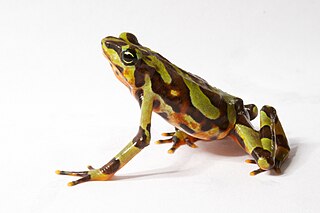
Atelopus varius, the Costa Rican variable harlequin toad or clown frog, is a small Neotropical true toad from the family Bufonidae. Once ranging from Costa Rica to Panama, A. varius is now listed as critically endangered and has been reduced to a single remnant population near Quepos, Costa Rica and has only relict populations in western Panama (IUCN). Recent variation in air temperature, precipitation, stream flow patterns, and the subsequent spread of a pathogenic chytrid fungus (Batrachochytrium dendrobatidis) linked to global climate change have been the leading cause of decline for A. varius. A. zeteki has been considered a subspecies of A. varius, but is now generally considered a separate species.

The starry night toad is a species of toad in the family Bufonidae endemic to the Sierra Nevada de Santa Marta, Colombia. Its natural habitats are sub-Andean and Andean forests, sub-páramo and páramo at 2,000–3,500 m (6,600–11,500 ft) above sea level. Reproduction takes place in fast-flowing rivers. It is named after its unique coloration, being largely black with white spots.
The Rio Carauta stubfoot toad is a species of toad in the family Bufonidae endemic to Colombia; this anuran is found only within the Northwestern Andean montane forests. Its natural habitats are subtropical or tropical moist montane forests and rivers. The species is threatened by habitat loss.
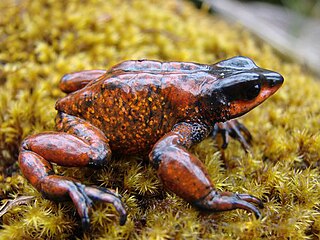
The Guajira stubfoot toad or Carrikeri harlequin frog is a species of toad in the family Bufonidae. It is about 5 cm (2.0 in) long and typically black, though some populations have orange coloration. This species is endemic to the Sierra Nevada de Santa Marta mountain range of northern Colombia. It is critically endangered because of the chytrid fungus, Batrachochytrium dendrobatidis, and habitat destruction due to agriculture. The species had not been seen from 1994 until it was rediscovered in early 2008.

Atelopus certus, the Darien stubfoot toad or Toad Mountain harlequin frog, is a species of toad in the family Bufonidae endemic to Panama.

Atelopus chiriquiensis, the Chiriqui harlequin frog or Lewis' stubfoot toad, is an extinct species of toad in the family Bufonidae that was found in the Cordillera de Talamanca in Costa Rica and western Panama. Its natural habitats were stream margins in lower montane wet forests and rainforests. Its elevational range was 1,400–2,500 m (4,600–8,200 ft) asl.
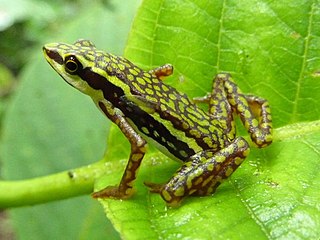
Atelopus coynei, the Rio Faisanes stubfoot toad, is a species of toad in the family Bufonidae endemic to Ecuador. Its natural habitats are subtropical or tropical moist lowland forests, subtropical or tropical moist montane forests, and rivers. It is threatened by habitat loss.

The elegant stubfoot toad or Pacific jambato frog is a species of toad in the family Bufonidae found in lowlands and Andean slopes of northwest Ecuador to 1,140 m (3,740 ft) asl and on the Gorgona Island, off southwest coast of Colombia. It was described by George Albert Boulenger in 1882 based on a specimen collected by Edward Whymper. It is known in Spanish as rana jambato del Pacífico or simply jambato del Pacífico.
Atelopus galactogaster, the Antado stubfoot toad, is a species of toad in the family Bufonidae endemic to Colombia within the northwestern Andean montane forests. The species' natural habitat is subtropical or tropical moist montane forests.

Atelopus laetissimus is a species of toad in the family Bufonidae. It is endemic to Colombia and only known from the area of its type locality in the northwestern part of the Sierra Nevada de Santa Marta, in the Magdalena Department.
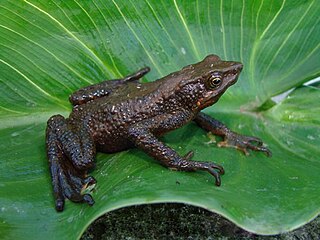
Atelopus nahumae is a species of toad in the family Bufonidae. It is endemic to Colombia and only known from humid montane forest of Sierra Nevada de Santa Marta in the Magdalena, La Guajira, and Cesar Departments.

Atelopus palmatus is a species of toad in the family Bufonidae. It is endemic to the Cordillera Oriental of eastern Ecuador and is known from the Napo and Pastaza Provinces at elevations of 1,150–1,740 m (3,770–5,710 ft) above sea level. Its type locality is "Rio Pastaza".
Atelopus petriruizi, more commonly known as the painted stubfoot toad, is a species of toad in the family Bufonidae. Endemic to Colombia, the toad's natural habitats are subtropical or tropical moist montane forests and rivers. Threatened by habitat loss, the Ateopus petriruizi is currently classified as critically endangered, and was placed on the IUCN red list in 2017. Currently, there may be less than 49 remaining mature A. Petriruizi.
Atelopus quimbaya is a species of toad in the family Bufonidae. It is endemic to Colombia and known from the western slopes of the Cordillera Central in Risaralda, Quindío, and Caldas Departments. Its natural habitats are sub-Andean and Andean forests at altitudes of 1,650–2,940 m (5,410–9,650 ft) above sea level. Chytridiomycosis is a serious risk to this rare species.
Atelopus subornatus is a species of toad in the family Bufonidae. It is endemic to Colombia and is restricted to the Cordillera Oriental in the Cundinamarca Department. Common name Bogota stubfoot toad has been coined for this species.
The Tamá harlequin frog or Venezuela stubfoot toad is a species of toad in the family Bufonidae. It is endemic to the Páramo de Tamá on the Venezuelan-Colombian border and occurs in Apure and (likely) Táchira states of Venezuela and Norte de Santander Department on the Cordillera Oriental of Colombia.

The Chocó–Darién moist forests (NT0115) is an ecoregion in the west of Colombia and east of Panama. The region has extremely high rainfall, and the forests hold great biodiversity. The northern and southern parts of the ecoregion have been considerably modified for ranching and farming, and there are threats from logging for paper pulp, uncontrolled gold mining, coca growing and industrialisation, but the central part of the ecoregion is relatively intact.

The Northwestern Andean montane forests (NT0145) is an ecoregion on the Andes mountains in the west of Colombia and Ecuador. Both flora and fauna are highly diverse due to effect of ice ages when the warmer climate zones were separated and the cooler ones combined, and interglacial periods when the reverse occurred. Because the environment is hospitable to humans, the habitat has been drastically modified by farming and grazing since the Pre-Columbian era.
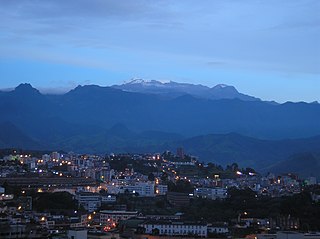
The Cauca Valley montane forests (NT0109) is an ecoregion in western Colombia. It covers the sides of the Cauca Valley, which runs from south to north between the Central and Western Ranges (cordilleras) of the Colombian Andes. The ecoregion is home to very diverse fauna and flora, due in part to its varied elevations and climates, in part to its position near the isthmus of Panama, the route along which North American species invaded South America and then diversified as they moved to the upper parts of the Andes. Little of the original habitat remains at lower levels, but higher up there are sizeable blocks of forest, some of which are protected.

The Santa Marta montane forests (NT0159) is an ecoregion in the Sierra Nevada de Santa Marta, a massif on the Caribbean coast of northern Colombia. The ecoregion covers altitudes from near sea level up to around 3,300 metres (10,827 ft), where it gives way to Santa Marta páramo. The isolation of the massif and the range of elevations and climates has resulted in a wide variety of species including many endemics. The lower levels contained tropical rainforest, which has largely been cleared. Higher up, this gives way to cloud forest. Much of this has also been cleared for coffee plantations, pasture for sheep and cattle, and farming.
















